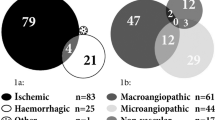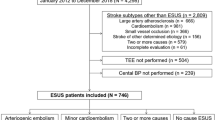Abstract
The aim of this prospective observational study was to determine the association of acute blood pressure values with independent factors (demographic, clinical characteristics, early complications) in stroke subgroups of different aetiology. We evaluated data of 346 first-ever acute (<24 h) stroke patients treated in our stroke unit. Casual and 24-h blood pressure (BP) values were measured. Stroke risk factors and stroke severity on admission were documented. Strokes were divided into subgroups of different aetiopathogenic mechanism. Patients were imaged with CT-scan on admission and 5 days later to determine the presence of brain oedema and haemorrhagic transformation. The relationship of different factors to 24-h BP values (24-h BP) was evaluated separately in each stroke subgroup. In large artery atherosclerotic stroke (n=59), history of hypertension and stroke severity correlated with higher 24-h BP respectively. In cardioembolic stroke (n=87), history of hypertension, stroke severity, haemorrhagic transformation and brain oedema were associated with higher 24-h BP, while heart failure with lower 24-h BP. History of hypertension and coronary artery disease was related to higher and lower 24-h BP, respectively, in lacunar stroke (n=75). In patients with infarct of undetermined (n=57) cause 24-h BP were mainly influenced by stroke severity and history of hypertension. An independent association between higher 24-h BP and history of hypertension and cerebral oedema was documented in intracerebral haemorrhage (n=68). In conclusion, different factors influence acute BP values in stroke subtypes of different aetiology. If the clinical significance of these observations is verified, a differentiated approach in acute BP management based on stroke aetiology may be considered.
This is a preview of subscription content, access via your institution
Access options
Subscribe to this journal
Receive 12 digital issues and online access to articles
$119.00 per year
only $9.92 per issue
Buy this article
- Purchase on Springer Link
- Instant access to full article PDF
Prices may be subject to local taxes which are calculated during checkout
Similar content being viewed by others
References
Wallace JD, Levy LL . Blood pressure after stroke. JAMA 1981; 246: 2177–2180.
Britton M, Carlsson A, de Faire U . Blood pressure course in patients with acute stroke and matched controls. Stroke 1986; 17: 861–864.
Yatsou FM, Zivin J . Hypertension in acute ischaemic strokes: not to treat. Arch Neurol 1985; 42: 999–1000.
Spence JD, Del Maestro RF . Hypertension in acute ischaemic strokes: treat. Arch Neurol 1985; 42: 1000–1002.
Bath FJ, Bath PMW . What is the correct management of blood pressure in acute stroke? The blood pressure in Acute Stroke Collaboration. Cerebrovasc Dis 1997; 7: 205–213.
Leonardi-Bee J, Bath PM, Phillips SJ, Sandercock PA . Blood pressure and clinical outcomes in the International Stoke Trial. Stroke 2002; 33: 1315–1320.
Lees KR, Dyker AG . Blood pressure control after acute stroke. J Hypertens Suppl 1996; 14: S35–S38.
Ogata J et al. Hemorrhagic infarct of the brain without a reopening of the occluded arteries in cardioembolic stroke. Stroke 1989; 20: 876–883.
Powers WJ . Acute hypertension after acute stroke: the scientific basis for treatment decisions. Neurology 1993; 43: 461–467.
Fischberg GM et al. Stroke precipitated by moderate blood pressure reduction. J Emerg Med 2000; 19: 339–346.
Hacke W et al. Acute treatment of ischemic stroke. European Stroke Initiative (EUSI). Cerebrovasc Dis 2000; 10(Suppl 3): 22–33.
Adams Jr HP et al. Stroke Council of the American Stroke Association. Guidelines for the early management of patients with ischemic stroke: a scientific statement from the Stroke Council of the American Stroke Association. Stroke 2003; 34: 1056–1083.
Bath P et al. International Society of Hypertension Writing Group. International Society of Hypertension (ISH): statement on the management of blood pressure in acute stroke. J Hypertens 2003; 21: 665–672.
Bath P . Alteplase not yet proven for acute ischaemic stroke. Lancet 1998; 352: 1238–1239.
Slyter H . Ethical challenges in stroke research. Stroke 1998; 29: 1725–1729.
Morfis L, Schwartz RS, Poulos R, Howes LG . Blood pressure changes in acute cerebral infarction and hemorrhage. Stroke 1997; 28: 1401–1405.
Jorgensen HS et al. Blood pressure in acute stroke. The Copenhagen Stroke Study. Cerebrovasc Dis 2002; 13: 204–209.
Harper G et al. The changes in blood pressure after acute stroke: abolishing the ‘white coat effect’ with 24-h ambulatory monitoring. J Intern Med 1994; 235: 343–346.
Coats AJ . Reproducibility or variability of casual and ambulatory blood pressure data: implications for clinical trials. J Hypertens Suppl 1990; 8: S17–S20.
Vemmos K et al. The Athens stroke registry: results of a five-year hospital-based study. Cerebrovasc Dis 2000; 10: 133–141.
Lindestrom E et al. Reliability of Scandinavian Neurological Stroke Scale. Cerebrovasc Dis 1991; 1: 103–107.
Adams Jr HP et al. Classification of subtype of acute ischemic stroke. Definitions for use in a multicenter clinical trial. TOAST. Trial of Org 10172 in Acute Stroke Treatment. Stroke 1993; 24: 35–41.
1999 World Health Organization-International Society of Hypertension Guidelines for the Management of Hypertension. Guidelines Subcommittee. J Hypertens 1999; 17: 151–183.
Chamorro A et al. Blood pressure and functional recovery in acute ischemic stroke. Stroke 1998; 29: 1850–1853.
Dul K, Drayer B . CT and MR imaging of intracerebral hemorrhage. In: Kase CS, Caplan LR (eds). Intracerebral Hemorrhage. Butterworth-Heinemann: Boston: 1994, pp 73–93.
Moulin T, Crepin-Leblond T, Chopard JL, Bogousslavsky J . Hemorrhagic infarcts. Eur Neurol 1994; 34: 64–77.
Britton M, Carlsson A . Very high blood pressure in acute stroke. J Intern Med 1990; 228: 611–615.
Christensen H, Meden P, Overgaard K, Boysen G . The course of blood pressure in acute stroke is related to the severity of the neurological deficits. Acta Neurol Scand 2002; 106: 142–147.
Harper G, Castleden CM, Potter JF . Factors affecting changes in blood pressure after acute stroke. Stroke 1994; 25: 1726–1729.
Franklin SS et al. Hemodynamic patterns of age-related changes in blood pressure. The Framingham Heart Study. Circulation 1997; 96: 308–315.
Glasser SP . On arterial physiology, pathophysiology of vascular compliance, and cardiovascular disease. Heart Dis 2000; 2: 375–379.
Staessen JA . Potential adverse effects of blood pressure lowering—J-curve revisited. Lancet 1996; 348: 696–697.
Davalos A et al. Deteriorating ischemic stroke: risk factors and prognosis. Neurology 1990; 40: 1865–1869.
Jorgensen HS, Nakayama H, Raaschou HO, Olsen TS . Effect of blood pressure and diabetes on stroke in progression. Lancet 1994; 344: 156–159.
Krieger DW et al. Early clinical and radiological predictors of fatal brain swelling in ischemic stroke. Stroke 1999; 30: 287–292.
Broderick JP, Brott TG, Tomsick T, Huster G . Ultra early evaluation of intracerebral haemorrhage. J Neurosurg 1990; 72: 195–199.
Hatashita S, Hoff JT, Ishii S . Focal brain oedema associated with acute arterial hypertension. J Neurosurg 1986; 64: 643–649.
Straandgaard S, Paulson OB . Cerebral blood flow and its pathophysiology in hypertension. Am J Hypertens 1989; 2: 486–492.
Saku Y et al. Hemorrhagic infarct induced by arterial hypertension in cat brain following middle cerebral artery occlusion. Stroke 1990; 21: 589–595.
The NINDS t-PA Stroke Study Group. Intracerebral hemorrhage after intravenous t-PA therapy for ischemic stroke. Stroke 1997; 28: 2109–2118.
Larrue V, von Kummer R, del Zoppo G, Bluhmki E . Hemorrhagic transformation in acute ischemic stroke. Potential contributing factors in the European Cooperative Acute Stroke Study. Stroke 1997; 28: 957–960.
Acknowledgements
We thank Miss Mary Batsara, Mrs Athina Peppa and Miss Angela Konstantinopoulou for their valuable help in data collection.
Author information
Authors and Affiliations
Corresponding author
Rights and permissions
About this article
Cite this article
Vemmos, K., Spengos, K., Tsivgoulis, G. et al. Factors influencing acute blood pressure values in stroke subtypes. J Hum Hypertens 18, 253–259 (2004). https://doi.org/10.1038/sj.jhh.1001662
Received:
Revised:
Accepted:
Published:
Issue Date:
DOI: https://doi.org/10.1038/sj.jhh.1001662
Keywords
This article is cited by
-
Relationship between mean blood pressure during hospitalization and clinical outcome after acute ischemic stroke
BMC Neurology (2023)
-
Biomarkers levels and brachial and central blood pressure during the subacute phase of lacunar stroke and other ischemic stroke subtypes
Journal of Human Hypertension (2020)
-
Controlling Hypertension After Severe Cerebrovascular Event (CHASE): study protocol for a randomized controlled trial
Trials (2018)
-
Blood Pressure Management for Acute Intracerebral Hemorrhage: A Meta-Analysis
Scientific Reports (2017)
-
Association of age and admission mean arterial blood pressure in patients with stroke—data from a national stroke registry
Hypertension Research (2016)



